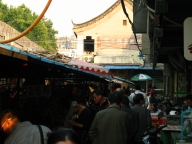Bazaar or Antiques Mall? You Decide!
Part 1 – Internet stores with brick mortar facades
Xuzhou is one of the oldest cities in China. Situated as the transportation hub in northwestern Jiansu province, it is less than a two and half hour ride away from either Shanghai or Beijing by high-speed train. Geographically the city is like Raleigh, NC in the US, with similar altitude and approximately three or four hours to the nearest seashore. Yet the climate in Xuzhou is harsher and drier.
Liu Bang, the first emperor of the Han Dynasty (206 BC–AD 220) was born in the region. Archeologists have found many royal family tombs from the Han Dynasty with extravagant jade clothing, terra cotta soldiers and stone carvings. If the Han Dynasty’s legacy can still be felt in a few local museums, the city has departed from its glorious past by building upon itself several times. Almost every existing building is no more than 30 years old.
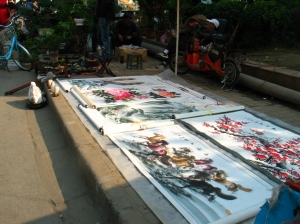
The biggest antiques market is in the center city, adjacent to the location of some original fortress wall relics (about 150 yards) from the 19th century. A few years ago, the city has rebuilt the walls and the gate, thus cladding the antiques market in a faux-ancient setting. Its official name is Hua Niao Shi Chang, which means flowers and birds market. As odd as it may sound, the name comes with the antiques trade tradition. In China, except items from early antiquity (such as bronze vessels from Shang and Zhou Dynasty, terra cotta or earthen ware from Qin and Han Dynasty) which are mostly studied and collected by state-wide institutions, the rest of antiques can be roughly divided into three hierarchical levels. The top is everything from the Royal family such as the porcelain made from Royal kilns, or the paintings owned by some emperors. The second is high art, artifacts owned and preferred by the intellectuals – furniture, paintings and calligraphy, fine porcelains, ink slabs, etc. Because these are the symbolism of Chinese scholars’ pursuit of pure aesthetics and spiritual freedom, they were seldom traded publicly in the ancient times. Lastly, bonsai, gold fish, and birds, in the Qing Dynasty, were common hobbies among the well-to-do. The public markets for hobbies have gradually grown to incorporate other folk art objects, which comprise the third and bottom tier.
The fact that such flower and bird markets were originally established for the lower end and now have to open up to incorporate the high end items poses a great challenge to the credibility of the trade. Naturally one would hesitate to pay 10 grand for a vintage watch in an antiques mall filled with grandma’s kitchen stuff. Yet stories have been circulated about some great findings in such markets. Chinese antiques collectors have even coined a term for such a phenomenon — “Jian Lou,” which means to pick up treasures others have overlooked.
Before I headed to Xuzhou’s Hua Niao Shi Chang, my friend, who studied in traditional ink wash paintings, told me there was no Jian Lou nowadays. Antiques shoppers in the US who have been to Brimfield or Round Top may understand the importance of being there EARLY. Those wee hour deals have been heard of in China back in the 80’s and 90’s when peasants put out whatever they dug out of the fields and sold to whoever made the first offer so that they could get back to work before noon. I was assured that there were no peasants around the markets anymore. Apparently now if they look like peasants and tell you that they don’t know what they are selling, they are just bad actors. Another interesting common feature between Brimfield or Round top and HuaNiao Shi Chang is that besides the indoor setup, there are also open areas claimed by more budget-constrained dealers. “Di Tan” refers to those ground area used by merchants who don’t own a booth (hence most likely no legal business license) and display their merchandise usually along a sidewalk. My friend warned me not to bother with those who don’t even have a booth. “Di Tan things are either not old or just fake.”
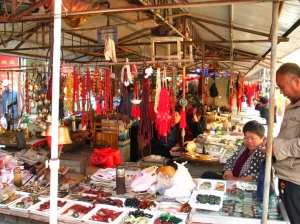
Yet I just couldn’t help looking around at those Di Tan. Upon arrival, I first noticed a few dealers put out some calligraphy works on the ground. It would cause any paper conservator anguish to see these were displayed near a heavy traffic intersection and the amount of exhaust from motorized bike was enough to cause health concerns. Later, I learned many of such calligraphy works, albeit very impressive, are either reproductions or imitations. By imitation, it means that instead of having one stroke from a big writing brush, the artist will use a tiny brush to fill the space, similar to the techniques used by children with coloring books. “A brush stroke has its own life, with a start and an end; and a good artist shows nuances through one simple straight stroke by varying the strength in the wrist and arms,” my friend said, “Each of these imitated brush strokes are comprised of many tiny strokes which strive to copy the overall shape, but fail to form a coherent ‘stroke life.’” Despite what she taught, I was still not sure of the difference; yet I know in my mind I could not take them seriously when they were not properly hung on the wall.
The entrance to the market got really crowded as I walked closer. Both sides of the sidewalks were cramped with dealers selling used art books, home-made crafted gourds, and stuff not too different from an American family’s yard sale.
I quickly browsed the art books of Di Tan. Most were related to calligraphy and traditional Chinese ink wash paintings, but interestingly there were some childrens comic books dated from The Cultural Revolutions period. The Chinese name for such books is “Lian Huan Hu” which means books of picture strips. Born at the end of the turmoil, I did not have the chance to read such “red” children books when I was a child. The auction record for any Chinese children comic book is 220,000RMB or $35,000 from a book published in the Republic period (1911 – 1949). Collectors of Chinese comic books are younger than those of fine arts or porcelains. These books ranged from 20 to 50 RMB (or $3 to $6) based on the condition, but books from the earlier period of the Cultural Revolution (1960’s instead of 1970’s) may fetch more than $50. One may think the return on investment seems significant considering they generally cost less than 10 cents originally; yet they are still not big-ticket items and the market has stabilized in recent years. Little profit can be made if they were not bought from estate. The popularity of such comic books reflects the nostalgia of the grown-up who lament the disappearance of comic books in the lives of their own children.
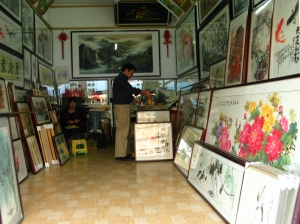
Once I was inside the market, I felt it was more of a bazaar than an antique mall. The pedestrian road between brick-walled stores becomes another aisle (under a big tent) with two lines of dealers back to back. It was hard for me to see the actual store front as I was mostly forced to walk on their storefront steps. Strangely, the brick and mortar stores had few visitors even though there was much nicer merchandise inside. The middle aisle dealers sell mostly small items such as coins, jade, small Buddha statues, necklaces, braces or other handcraft objects. And they were swamped.
As always with any outdoor malls in China, street food is an integral part of the shopping experience. A woman walked nimbly carrying two buckets of jellied bean curd on a bamboo pole. It tasted delicious until I found out that I was standing next to a trash bin overflowing with food waste. I looked around and began to realize it was one of the least organized and dirtiest places in the city. I immediately dumped the rest of the tofu into the bin.
Afterward, I began to visit different stores. In most cases, I was the only visitor. Some were a pleasure to see; such as a store specializing in mounting and framing Chinese paintings, a store selling four treasures of the study (brush, ink, paper and ink stone) and a seal carver who only rents the foyer of a painting store.
But interestingly, I noticed in almost every store, the owners seemed occupied. The frame store is more or less a workshop. Three female artisans were working fervently on a batch order when I was there. It is a great selling point when what you see is not a finished product but a working progress toward perfection. The seal carver took multiple orders a day. He does not work during the store hours as the crowd and noise are too much a distraction against the exact nature of the stone carving. When I was in the store selling calligraphy items, the owner just got a UPS delivery of some artwork. The ink wash works on paper have some dashy colors, giving them a distinct modern look. He grudgingly took a pair of seals out of a glass cabinet upon my request. There was no price tag. When I asked the best he could offer, it seemed that an arbitrary (high) number came out of his mouth.
Similar to the US, China’s brick and mortar antiques stores are evolving to accommodate e-commerce. As credibility has become the number one of issue in antiques trade in China, store owners have found a new frontier that not only broadens their audience base, but strengthens their reputation by aptly adopting online business. Many websites for antiques trades exist. There are some national websites such as yicui (www.artww.com/) , bobao (www.artxun.com/), or websites that provide localized services such as xuzhou.edeng.cn/33/guwan/ (which works like a craigslist with better pictures). Most websites provide seller ratings, similar to the mechanism used by eBay or Amazon. While the former provide a platform to attract non-local antiques collectors, many localized websites lists items that specify face-to-face transaction at the stores. The on-site transaction requirement adds additional transparency by providing a space for authentication and possibly negotiation. For potential buyers, a dealer with a physical store is more trustworthy in the online business than an anonymous seller who may “disappear” after fraudulent or dubious transactions.
The on-line activity of stores can be seen through the eBay-looking webpages on almost every computer used by the store owners. Even the seal carver has built his own website and is actively engaged in discussions of some collector forums. Instead of using regular email, he uses QQ, China’s equivalent of Facebook not only provides personal updates with connected circles, group/fan but also includes actual email.
When glimpsing the computer screen at a store selling tea pots and scholar’s rocks, I memorized one website: www.sssc.cn/. I was not sure whether the store owner was buying/selling or just watching, but the website seemed comprehensive and the transaction amount looked fairly large.
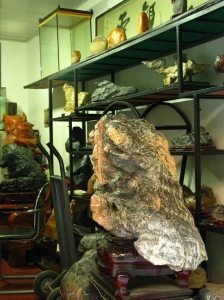 (According to their website press release from this summer, in average online auction item fetches about 700 dollars.) The auction uses a mechanism similar to eBay, but with some advantage borrowed from on-site auctions. Besides buy-it now price (upper limit) and reserve price (lower limit) each item will be sold to the highest bidder who is not rivaled within 24 hours after the bid is placed. To strengthen the credibility issue, all items have the 7-day return policy. It is a dramatic change to the current default no-return policy in the trade. (It is a buyer’s fault if he ends up buying fakes.) In addition to the typical rating, there are two special labels – untrustworthy and strongly not recommended – used for the special occasions when the dispute investigated by the company turns in favor of the buyer. Such special labels will not be removed forever and to some extent deter some fraudulent activities.
(According to their website press release from this summer, in average online auction item fetches about 700 dollars.) The auction uses a mechanism similar to eBay, but with some advantage borrowed from on-site auctions. Besides buy-it now price (upper limit) and reserve price (lower limit) each item will be sold to the highest bidder who is not rivaled within 24 hours after the bid is placed. To strengthen the credibility issue, all items have the 7-day return policy. It is a dramatic change to the current default no-return policy in the trade. (It is a buyer’s fault if he ends up buying fakes.) In addition to the typical rating, there are two special labels – untrustworthy and strongly not recommended – used for the special occasions when the dispute investigated by the company turns in favor of the buyer. Such special labels will not be removed forever and to some extent deter some fraudulent activities.
I visited the Hua Niao Shi Chang many times during my stay in Xuzhou. In the next few visits, I have learned to avoid food stands totally since my initial visit, what was not changed was the jarring contrast between the elbow-to-elbow crowd for the middle crafts aisle and the regular antiques stores which seemed to have more deliveries than visitors. To some extent, they are becoming an online store with brick mortar facades.
Discover more from Urban Art & Antiques
Subscribe to get the latest posts sent to your email.

